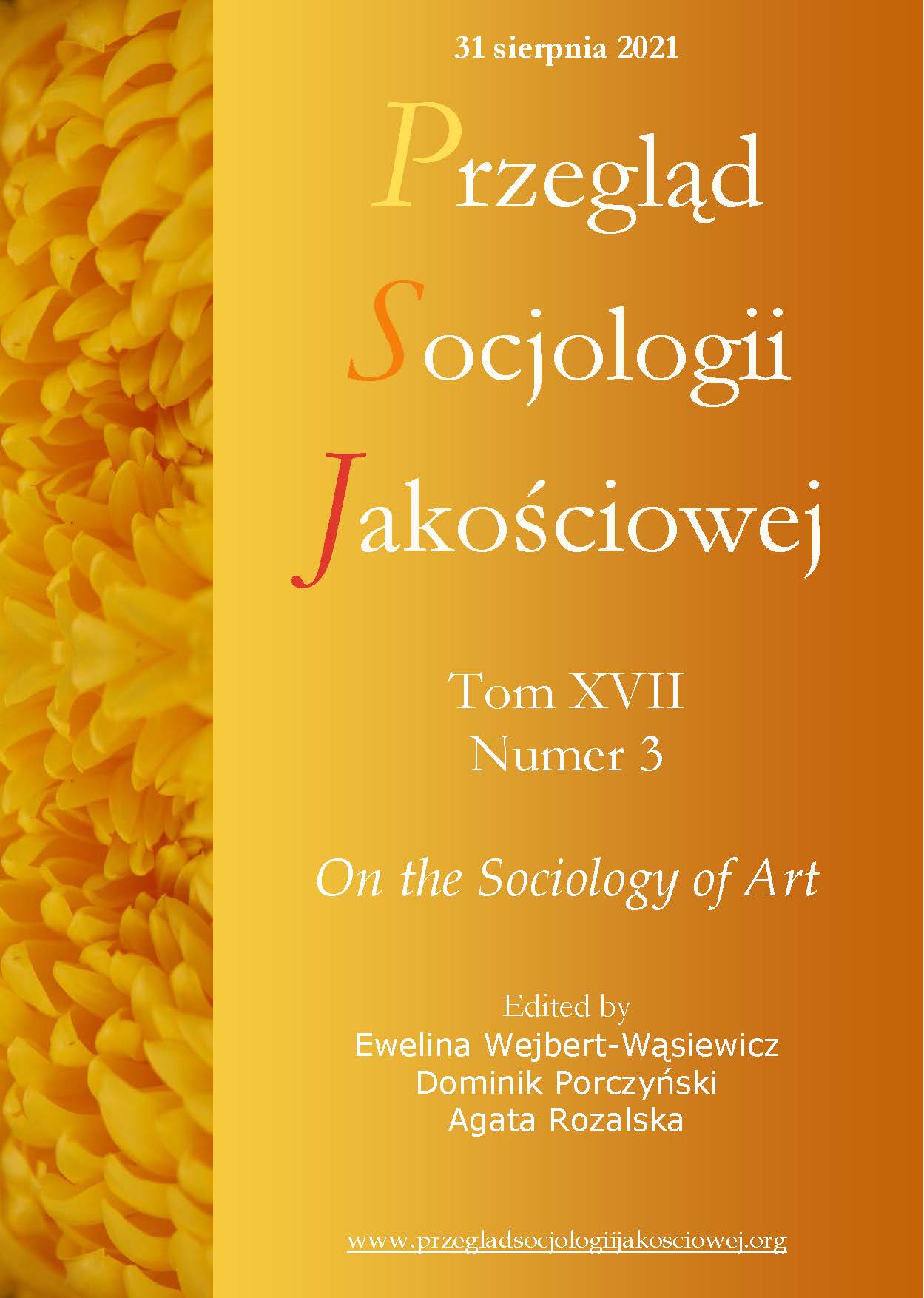Dilip Kumar: autor-aktor
DOI:
https://doi.org/10.18778/1733-8069.17.3.12Słowa kluczowe:
Howard Becker, Dilip Kumar, film studies, sztuka i kultura, socjologia pracy, film i kulturaAbstrakt
Dilip Kumar był chwalony za wysublimowane prowadzenie dialogów, opanowaną gestykulację oraz za wyważone i kontrolowane wyrażanie emocji zarówno w opowieściach tragicznych, jak też w beztroskich komediach. Jego debiut w 1944 w Jwar Bhata (Odpływy i przypływy) spotkał się z niezbyt pochlebnymi recenzjami. Podobnie było z kolejnymi trzema filmami, aż do filmu Jugnu (Świetlik) z 1948 roku, który przyniósł mu uznanie i sukces. W przeciwieństwie do swoich rówieśników, jak Raj Kapoor iDev Anand, którzy napędzali kariery, uruchamiając własne firmy produkcyjne, Dilip Kumar polegał na swoim talencie, unikalnym podejściu do charakteryzacji i zaangażowaniu w projekty, których się podjął. W ciągu swojej sześćdziesięcioletniej kariery Kumar nakręcił tylko 62 filmy. Jednak jego praca jest podręcznikowa dla młodszych aktorów. Nie tylko przyniósł szacunek zawodowi aktora, traktowanemu przez indyjskie klasy wyższe jako zawód „alfonsów i prostytutek”, ale także podniósł aktorstwo filmowe i filmowanie do dyscypliny akademickiej, co uczyniło Kumara godnym tytułu emerytowanego profesora aktorstwa. Artykuł ten, zakorzeniony w ramach teoretycznych pracy Howarda S. Beckera nad „produkcją kultury” i „robieniem rzeczy razem”, omawia podejście Kumara do aktorstwa i rozwoju postaci oraz poziom jego zaangażowania w każdy ze swoich projektów. Autor tego artykułu przekonuje, że to artystyczne zaangażowanie i poświęcenie głównych aktorów kształtują wielkie dzieła sztuki w kinie bardziej niż kontrola twórcza producenta czy reżysera. Dilip Kumar wielokrotnie to zademonstrował.
Pobrania
Bibliografia
Ahmad, Syed Areesh. 2019. “Remembering Dilip Kumar on his 97th birthday.” Retrieved June 23, 2021 https://www.asiaville.in/article/remembering-dilip-kumar-on-his-97th-birthday-23844
Google Scholar
Ayaz, Shaikh. 2018. “The glorious legacy of Dilip Kumar, arguably the subcontinent’s first method actor.” The Indian Express. Retrieved June 23, 2021 https://indianexpress.com/article/entertainment/bollywood/glorious-legacy-of-dilip-kumar-first-method-actor-5487659/
Google Scholar
Becker, Howard S. 1982. Art Worlds. Berkeley: University of California Press.
Google Scholar
Becker, Howard S. 1986. Doing Things Together: Selected Papers. Evanston: Northwestern University Press.
Google Scholar
Bollywood Aaj Aur Kal. 2020. “Naushad Ji talks about Dilip Kumar Sahib - Part-5 - Bollywood Aaj Aur Kal.” Retrieved June 23, 2021 https://www.youtube.com/watch?v=VlYzReIKn-w
Google Scholar
Chakravarty, Sumita. 1993. National Identity in Popular Indian Cinema – 1947-1987. Austin: University of Texas Press.
Google Scholar
Chung, Sonya. 2010. “I Heart Chekhov; Better Than Booze or Smokes.” The Millions. Retrieved June 23, 2021 https://themillions.com/2010/05/i-heart-chekhov-better-than-booze-or-smokes.html
Google Scholar
Cole, Nicki Lisa. 2019. “The Life and Work of Howard S. Becker” ThoughtCo. Retrieved June 23, 2021 https://www.thoughtco.com/howard-becker-3026481
Google Scholar
Desai, Meghnad. 2005. Nehru’s Hero: Dilip Kumar in the Life of India. New Delhi: Roli Books.
Google Scholar
“Dilip Kumar Interview.” 2018. Prasar Bharati Archives. Retrieved June 23, 2021 https://www.youtube.com/watch?v=6b8HnWsTreU
Google Scholar
Farookh, M. B. 2020. “The Kohinoor in the Crown of Indian Cinema.” Mouthshut.com Retrieved June 23, 2021 https://www.mouthshut.com/review/Dilip-Kumar-review-rmnplllnsno
Google Scholar
Guback, Thomas. 1969. The International Film Industry. Bloomington: Indiana University Press.
Google Scholar
Gupta, Rajan Das. 2010. “There’s method in his acting.” The Tribune. Retrieved June 23, 2021 https://www.tribuneindia.com/2010/20100627/spectrum/main7.htm
Google Scholar
Kahlon, Sukhpreet. 2019. “Jwar Bhata (1944): When Dilip Kumar’s performance got him a zero.” Cinestaan. Retrieved June 23, 2021 https://www.cinestaan.com/articles/2019/nov/29/23410/jwar-bhata-1944-when-dilip-kumar-s-performance-got-him-a-zero
Google Scholar
Kumar, Dilip. 2014. The Substance and the Shadow. An Autobiography. New Delhi: Hay House Publishers.
Google Scholar
Kumar, Dilip. 2016. “Dilip Kumar on Bimal Roy and Devdas.” Dailyo.in. Retrieved August 19, 2021 https://www.dailyo.in/arts/bimal-roy-dilip-kumar-devdas-nasreen-munni-kabir-the-silent-thunder-channel-4-uk/story/1/8341.html
Google Scholar
Lent, John. 1990. The Asian Film Industry. Austin: University of Texas Press.
Google Scholar
Mahaan, Deepak. 2010. “Aadmi (1968).” The Hindu. Retrieved June 23, 2021 https://www.thehindu.com/features/cinema/Aadmi-1968/article16576648.ece
Google Scholar
Naipaul, Vidiadhar S. 1977. India: A wounded civilization. New York: Vintage Books.
Google Scholar
Nazir, Asjad. 2019. “A legendary actor in his own words.” EasternEye. Retrieved June 23, 2021 https://www.easterneye.biz/a-legendary-actor-in-his-own-words/
Google Scholar
Rangan, Baradwaj. 2014. “The King of Tragedy.” The Hindu. Retrieved June 23, 2021 https://www.thehindu.com/books/books-reviews/review-of-dilip-kumar-autobiography/article6258685.ece
Google Scholar
Rishi, Tilak. 2012. Bless You, Bollywood!: A Tribute to Hindi Cinema on Completing 100 Years. Bloomington: Trafford Publishing.
Google Scholar
The News. 2013. “Dilip Kumar… in his own words.” Retrieved June 23, 2021 https://www.thenews.com.pk/tns/detail/554372-dilip-kumarin-words
Google Scholar
Pobrania
Opublikowane
Jak cytować
Numer
Dział
Licencja

Utwór dostępny jest na licencji Creative Commons Uznanie autorstwa – Użycie niekomercyjne – Bez utworów zależnych 4.0 Międzynarodowe.














